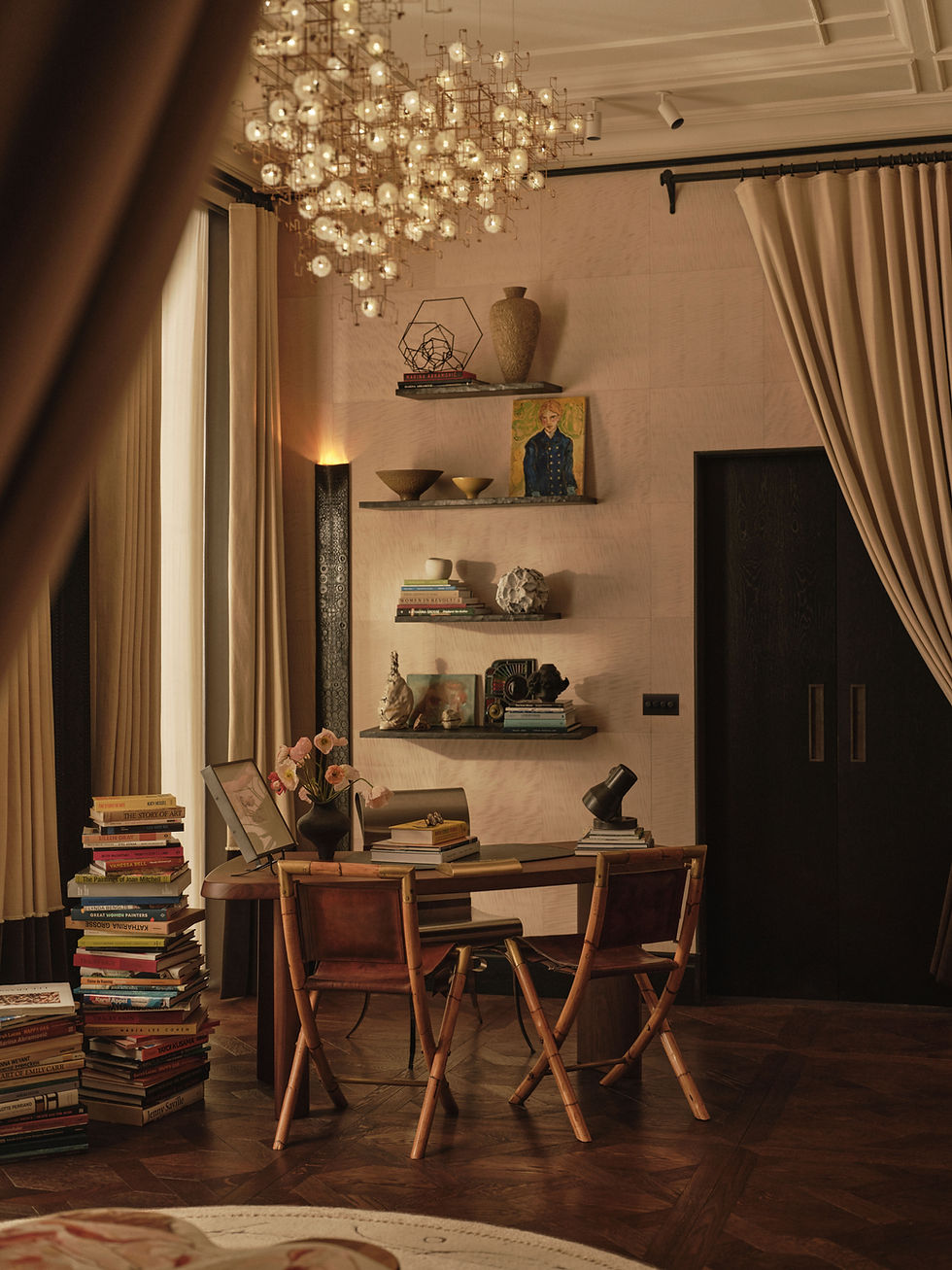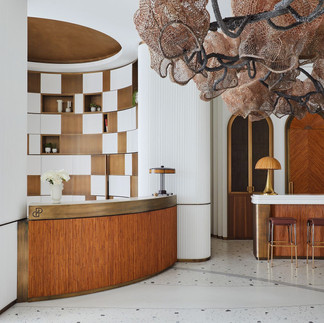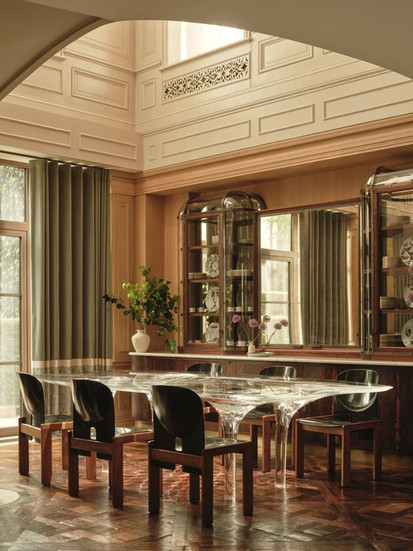The Art of Collecting: How Brigitta Spinocchia Freund Transforms Spaces into Personal Narratives
- Mumble Forum

- Jun 16
- 7 min read
Updated: Jun 17
Hello, Brigitta, It’s wonderful to meet you. We are in awe at Mumble of your incredibly inspiring and successful 25+ year interior design career.

Can you take us back to the beginning, and tell us how your interiors story began?
I didn’t take the traditional route into interiors. My early interests were rooted in fashion, and I always knew I wanted to be a designer in some capacity. It wasn’t a straight path, but the creative thread was always there. After nearly a decade as Creative Director at a leading design studio, I founded my own firm and that’s where I truly discovered my passion for
interiors.Looking back, design was always in my blood. My parents had their own antiquities store and imported and exported Italian furniture, and both my grandfather and great- grandfather worked in construction, so I grew up with an instinctive understanding of how spaces come together. I’ve always been drawn to people who take unconventional paths, creatives like Thomas Heatherwick and John Pawson, who didn’t necessarily follow formal routes, but have shaped the design world through vision and originality. That’s what design is really about for me: instinct, imagination, and the courage to
push boundaries.
2. On your firm, Spinocchia Freund’s website, you speak about “Design DNA”. How would you describe yours, and the personal signature you bring to each project?
Our Design DNA is built on storytelling, craftsmanship, collaboration, and a thoughtful blend of heritage and innovation. While every project is entirely unique, there’s always a consistent thread; a sense of depth, authenticity, and a balance between the contemporary and the timeworn.
I’m passionate about creating spaces that feel deeply personal to the client. That means working with bespoke pieces, layering textures, and curating a dialogue between antique and modern elements. For me, it’s never just about how a space looks it’s about how it makes you feel. Mood and emotion often become the guiding forces. We shape this through both the architectural framework and the careful selection of furniture, art, and finishes. The result is a space that resonates on a human, emotional level.
3. Collector’s House, your high-profile recent project in Chelsea Barracks, is now on the market for £45million. It is spectacular. What was your vision for this property, and what differentiated this project from others that you have worked on?
The vision for Collector’s House was to create a home that felt as though every piece,
from the art to the furniture, told a story and was part of a collection. It wasn’t about simply filling a space with beautiful things; it was about crafting an environment where every object had meaning, history, and a sense of belonging.
With over two decades of experience, we’ve built deep relationships with dealers, antique specialists, and auction houses, which allowed us to source extraordinary pieces: ten attributed Pierre Jeanneret dining chairs, Afra and Tobia Scarpa’s Africa chairs, a rare 1930s André Arbus cabinet, Jacques Adnet’s leather easy chairs, and an original 1950s Noguchi lamp, to name a few. These aren’t just design statements; they are touchpoints in a narrative that connects past and present.
I wanted to create a space that felt both sophisticated and deeply personal; where art, architecture, and interiors coexisted harmoniously. At its core, Collector’s House is about connection: a home where people can engage with the objects around them, where everything has a purpose, and where the atmosphere feels natural and inviting.
4. You are known for curating and collecting art and furniture, and for blending old and new. How did you achieve this juxtaposition in Collector’s House, and why is this
important to you throughout your design portfolio?
This balance is what makes a space feel authentic and alive. In Collector’s House, much of the design process was spent testing antique pieces alongside contemporary ones; layering works and furniture from different eras to create a dialogue between them. It isn’t the quickest approach; it takes time, patience, and judgement to source one-of-a-kind objects, whether old or new, that give the home its unique character. But it’s precisely this process that prevents interiors from feeling too ‘staged’. Instead, they feel lived-in, evolving, and reflective of a collector’s journey over time.
I’m especially passionate about collectible art and art furniture because these pieces blur the line between function and expression. They carry stories, provoke emotion, and elevate everyday living into something more meaningful. Bringing these elements into my interiors isn’t just about aesthetics it’s about creating a deeply personal and enduring atmosphere.
5. Do you have a favourite space in Collector’s House, and why?
It’s hard to choose just one, each room serves a different purpose depending on the time of day and the mood I’m hoping to evoke. But if I had to pick, by night, it would definitely be the speakeasy. It’s more than just a visually striking space; it’s designed to stir emotion. Being in there feels immersive, almost like time stands still, and it’s easy to become completely present. You get lost in time with the carefully curated vinyl collection and the perfect crackle of your tunes drifting through the room. The block-pattern carpet, the opulent fabric-covered panelling, the vintage leather chairs every detail contributes to the atmosphere. It’s intimate yet full of character. It’s the kind of room where anything could happen, and that unpredictability is exactly what I love about it.
6. Your firm and team bring together interior architecture and interior design. How does this expertise in both areas inform your approach, and how do they influence each other?
Interior architecture and interior design are fundamentally interconnected in our work at Spinocchia Freund. I take great pleasure in exploring the architectural elements of a property, understanding its flow, proportions, and potential. This architectural foundation is critical, as it informs every subsequent design decision,from ceiling heights and mouldings to the integration of bespoke joinery. Once the framework is established, we begin the rewarding process of layering in furniture, fabrics, and art to bring the space to life. What I find particularly engaging is exploring how a space can evolve, often designing rooms to be multi-functional, adapting to different needs and moments throughout the day. Collaborating with artists and makers further enriches the narrative, adding emotional and visual depth, while comfort and practicality remain essential to every project.
7. How has your cultural heritage and love of travel, informed your work?
I grew up surrounded by beauty, history, and craftsmanship. My parents were important exporters of furniture and had a deep love for collectible antiques from Greece and Turkey. From an early age, I was immersed in a world where objects told stories; each piece carefully sourced during our travels, each journey an education in culture, form, and material. Traveling with them to hidden markets and historic sites across different countries instilled in me an intuitive understanding of design and a reverence for the past. That foundation shaped my creative practice profoundly. I’m drawn to pieces and spaces that feel timeless, layered, and soulful designs that carry the same sense of discovery and storytelling that surrounded me growing up.

8. You are a patron of the British Fashion Council, and have a stunning fashion archive. Can you tell us how fashion has shaped and influenced you – and how it influences your interior design process?
Fashion and interiors are deeply connected. Both are about self-expression, proportion, and craftsmanship. My love for fashion has taught me how to play with silhouettes, textures, and layering, all principles I bring into my interior work. There’s also a narrative quality to fashion that resonates with me; the way a couture piece tells a story through its construction mirrors how a well-designed space can evoke emotion and personality.
As a patron of the British Fashion Council, I’m passionate about championing emerging talent across the board. I’ve just reviewed the latest cohort of BFC winners, and I’m constantly inspired by the innovation they bring. That energy directly influences my work In fact we’re currently developing a project that invites fashion designers into the world of interiors, which will launch as a special event next year. We also have a collaboration a great female fashion designer who is creating a bespoke ceiling design. These cross-disciplinary partnerships keep our studio dynamic, diverse, and continually evolving.
9. Can you tell us about your home? What does ‘home’ mean to you?
For me, home is deeply personal and a reflection of the all the things I love, the experiences I’ve had, and the people who matter most. It’s not about perfection; it’s about creating a space that feels authentic and lived in.
My home is a constantly evolving collection of pieces I’ve sourced over the years, some from travels, others from dealers and auction houses I’ve built relationships with. I love the conversation between old and new furniture pieces, and I’m drawn to objects with history, narrative and process, whether it’s a sculptural chair, a beautifully patinated table, or a work of art that sparks conversation. But some of my most treasured pieces are the artworks created by my children, which are in every room of my home. They bring a unique energy and personal narrative to the space that no collector’s item ever could.
Ultimately, home is about comfort and connection. It should be a place that feels instinctively right, where everything has been chosen with care and intention. How we feel our home is the most important to me and my family.
10. What’s next for you, and Spinocchia Freund?
There’s a lot on the horizon for me and Spinocchia Freund. One of the most exciting projects we’re currently working on the key penthouse within the redevelopment of Whiteleys, one of London’s most iconic buildings. We have worked on this with our client for 4 years now, and I think it will be another two years before completion. We are also working on the Wow!house, and our space called The Curator’s room: it’s an incredibly immersive space launching to the public on 3rd June.
I’m also honoured to be sponsoring the Collect Open prize this year as part of a three-year partnership. Supporting emerging talent has always been important to me, and this initiative allows us to champion innovative makers and artists who are pushing boundaries in craft and design. Nurturing the next generation of creatives is something I’m deeply passionate about, and I love being able to give them a platform to showcase their work.
Thank you so much for your time, Brigitta. We can’t wait to follow more of your journey!























